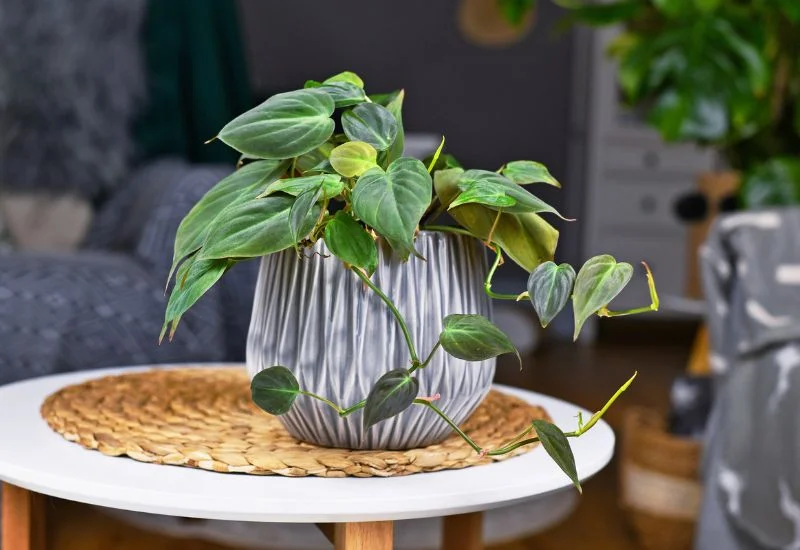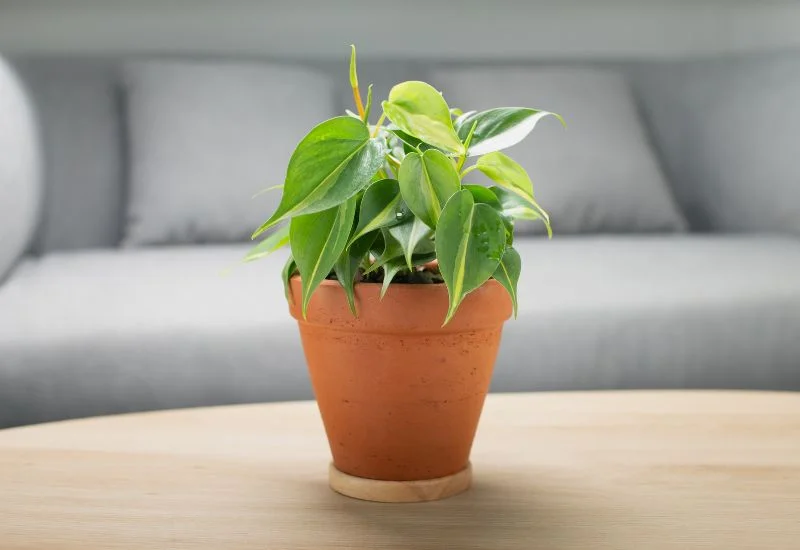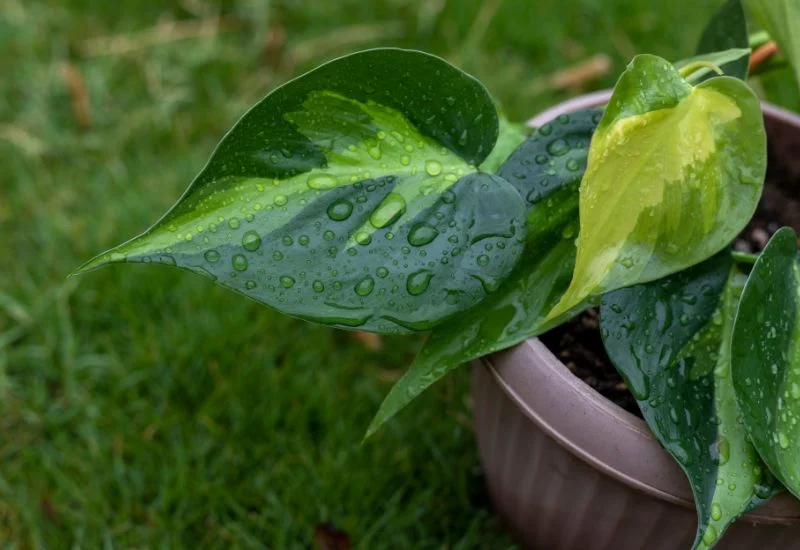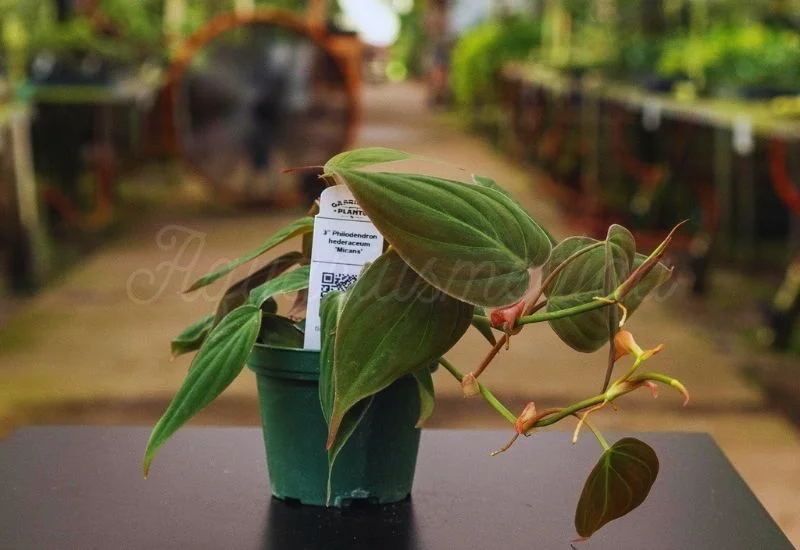In this blog post, you’re going to learn how to easily propagate and care for Philodendron Hederaceum.
This is a comprehensive guide covering reliable information about different aspects of this variety.
In this post, I’ll cover:
- Interesting Facts
- Propagation
- Repotting
- Care
And
- Solutions to Common Problems
So, if you are looking to propagate and care for Philodendron Hederaceum, this guide is for you.
Fun Facts
| Common Name | Heartleaf Philodendron |
| Botanical Name | Philodendron scandens, Philodendron acrocardium |
| Family | Araceae |
| Plant Type | Perennial |
| Fruit | Small barrey-like |
| Mature Size | 4-6 ft. tall, 1-6 ft. wide |
| Sun Exposure | Partial (Bright indirect light) |
| Soil Type | Well drained and moist |
| Soil pH | Acidic |
| Native Area | Tropical (Central America) |
| Toxic | Toxic to humans and pets (fetal for children) |
| Growth | Fast growing |
Heartleaf philodendron, or the scientific name Philodendron hederaceum, is an easy-to-care stunning plant that beginners and professionals can both grow. It is nearly similar to other Philodendron species, and hence, it can be mistaken for different species due to the similarities in its leaves and growth pattern. Still, what makes Philodendron hederaceum outstanding is that the leaves are heart-shaped and green but turn to a bronze color if grown under low light.
Climbing and trailing ability and flexibility to flaming light also make this plant popular with beginners and experienced flora lovers.
This plant is characterized by moderately fast growth, provided that the conditions of its development are satisfactory. This plant prefers and grows well in warm and humid climates with indirect light, though it can also grow under low light. It is a perennial plant that actively grows throughout the year, but perhaps with a slowdown during the winter time.
It should be watered often and fed occasionally with an optimal supply of food when it is in the growing season. Because this plant is fast growing it can reach several feet tall if it has a structure to climb or if allowed to trail. It can be pruned to its size thus it to promote bushier growth.
Flowering and Fruits in P. Hederaceum

The flowers of Philodendron hederaceum, like flowers of many aroids, are quite insignificant in comparison with the magnificence of the leaves. The primary whorl contains two parts; spathe, which is a leaf-like protection for the spadix, as is common in the Araceae family.
The spathe is ordinarily greenish to whitish and relatively small and camouflaged, enclosing the spadix, on which the actual small flowers are located. One cannot consider Philodendron hederaceum as a flowering plant as it is appreciated more for its foliage. However, the appearance of flowers is helpful from a botanical viewpoint.
The fruit structure of the plant, in particular, depends on the development of its flower. After successful pollination, which is a very uncommon occurrence in the indoor environment, the spadix may produce small, greenish, or reddish, berry-like structures. These fruits are usually inconspicuous and serve a different purpose of cultivating the plant. In the natural state, these fruits may help in the distribution of the seeds while in cultivation.
Benefits
Here are the major benefits of the Philodendron hederaceum;
Philodendron hederaceum is considered one of the most effective plants used to purify the air. It specifically excludes most of the indoor pollutants including formaldehyde, benzene, and trichloroethylene. In this way, it promotes a cleaner and healthier indoor environment. This makes it ideal to be used in homes and offices to improve the beauty as well as air quality.
When P. hederaceum is placed inside a home or working space, can provide an improvement in the room’s humidity content. It increases the level of humidity, which minimizes the risks of respiratory ailments and helps to prevent skin dryness.
Philodendron hederaceum is one of the most versatile plants, and its low maintenance is one of its biggest perks. This plant is adaptable from low to bright indirect light and thus does well in most indoor settings, including low-light offices.
Philodendron hederaceum is moderately drought-resistant and can survive in little bit tough conditions. It must only be watered when the potting mix on the top inch feels to be dry.
Due to its oval-shaped leaves and climbing nature, Philodendron hederaceum is an attractive plant that may be used to improve the appearance of an area. It can be placed as a hanging plant or a top shelf plant.
Unlike other plants that lose their aesthetic value at one point in the year, Philodendron hederaceum grows as a green plant throughout the year. Due to this, there is guaranteed aseptic color at all times, and this makes it a perfect plant for any indoor garden.
Research has also revealed that indoor plants help to reduce stress and boost p[productivity. So, it is best to increase productivity in the home, office, study area, or any other working space.
Uses
Here are a few uses of the philodendron hederaceum;
Indoor Decoration
Philodendron hederaceum is one of the preferred choices in indoor design and beauty. It’s popular among indoor gardeners due to its green foliage with a unique and classy texture.
Air Purification
Heartleaf philodendron is well known for its air-filtering property. It can filter out the major toxins from the air like; formaldehyde and benzene, etc.
Low-Maintenance Planting
It is not too sensitive to water and diet routine. So, easy to manage for novice gardeners.
Gift Plant
P. hederaceum is mainly picked up as a gift plant due to its low maintenance and appealing aesthetics.
Propagation

Just like the maintenance and care, the propagation of this plant is also easy. The most common method of its propagation is stem-cuttings.
Step-by-Step Guide to Propagation
Let’s explore the step-by-step guide to its stem-cutting propagation;
Select a Healthy Stem
A healthy and actively growing stem should be chosen for better propagation results. Select a stem that has a few leaves as well as nodes (nodes are the points from where the growth originates) on it.
Cut the Stem
Cut a 5-6 inches long selected stem with a sharp knife or scissors.
Remove Lower Leaves
Remove all the lower leaves of the stem but not 2-3 leaves on the top side. This will help to save energy for the production of roots.
Rooting the Cutting
After the cutting is prepared, there are two ways to root it;
Water Propagation: In this method, the stem is dipped in a glass of water. The roots start to appear in the 2-3 weeks. And change the water consistently after a few days.
Soil Propagation: In this method, we place the cutting directly in the maintained and well-balanced potting mix. Then the pot is placed in moist, bright, and indirect light. Roots emerge within 2-3 weeks.
Transplanting
After the roots are grown, wait until they reach up to 2-3 cm long. When roots grow sufficiently then transplant it in a pot with the regular potting mix. And start caring like a mature philodendron.
Repotting

Repotting is crucial for the healthy growth and maintenance of indoor plants. It helps to survive your indoor partner over a period of years.
When to Repot
- Signs: Repotting the plant is needed when the roots are tightly packed, roots are growing out of the drainage holes, or the soil is going to dry too fast.
- Frequency: Usually, a process of repotting in the Philodendron species is required after 2-3 years. Moreover, the manifest of the required signs for repotting is important.
Step-by-Step Guide to Repotting
When you are going to report your philodendron hederaceum, follow these steps carefully for the safe and efficient transfer of your beautiful masterpiece to the new pot;
Choose the Right Pot
Ensure that your newly selected pot has a well-draining system and is 1-2 cm larger in diameter than the previous pot.
Prepare the Potting Mix
Prepare a well-draining potting mix of peat, perlite, and vermiculite. A potting mix with this composition works well for tropical plants.
Remove the Plant from Its Current Pot
It is the most care-demanding step. You should keep your plant’s roots and stems safe and secure while removing them from the previous pot. Gently upside down the pot and support the plant with your hand. Then, slightly knock the pot from the sides and the back. If the plant is root-bound, then cut its edges with the walls of the pot using a sharp knife.
Inspect and Trim the Roots
Cut the damaged or dead roots because they are a burden for the plant. You should also inspect for any diseased or rotten roots. Otherwise, these roots will lead to serious complications after the growth is enhanced.
Report the Plant
Place a plant in the new pot containing a fresh potting mix. Ensure that the plant is at the same depth as in the last pot. Gently press the soil to remove the air pockets.
Water the Plant
Water the plant after repotting. It will help to make better contact between the plant roots and the new potting mix.
Post-Repotting Care
After the repotting, provide enhanced care to the plant for few weeks. In a short time, with proper watering and fertilizing plant will recover from the stress phase.
Care
The proper care and maintenance of your indoor plants not only improves their look but also makes indoor species survive longer and better. The following are some essential care considerations for the Philodendron hederaceum;
Pruning
Pruning is important in maintaining the shape and size of the plant. It is also helpful in the healthy growth of the plant. Regular pruning makes the plant beautiful as well as healthier.
Use a sharp knife or scissors for pruning. Moreover, first cut the dead and damaged parts, then prune the excessive growths.
Soil
A moist, well-draining, and fertilized soil is required for the proper growth of the P. hederaceum. A good potting mix is a mixture of peat, perlite, and compost, which retain moisture but avoid water-logging. The pH of the soil should be 6.0-7.0.
Pot
Pot size should be enough to provide proper room for the growth of roots but not too large to hold extra water. The draining holes are essential to remove the extra water.
The terracotta and ceramic-made pots are appreciated because they are porous. Moreover, the plastic made can also be used if have proper drainage.
Water
Water is a survival medium for any type of plants. But, in case of the Philodendrons the overwatering is a death-causing. Always water the plant when the top one inch of the soil dry. Water logging is not safe for the plant. It leads to root rotting and fungal growth.
Tap water is not safe for the plant because it contains the chlorine and other heavy metals. So, it is necessary to treat it before applying otherwise use filtered water.
Light
A bright and indirect light is appreciated in the growth of Philodendrons. Avoid direct sunlight to the plant. It can lead to yellow leaves and burning. This species requires 10-12 hours of light a day. If the naturally plant is not attaining this, then choose an artificial source of light.
Fertilizer
Feed your P. hederaceum with a fertilizer every 3-4 weeks, especially during the active growth period in summer and winter. Always use the fertilizer in the diluted form. It is easily absorbable and safe for the plant.
A composition of NPK (nitrogen, phosphorus, and potassium) with a ratio of 20:20:20 is a perfect choice. It is essential to reduce or stop fertilizing during dormancy or when there is no growth period.
Placement
Place the plant in a zone where it gets bright and indirect light. The countryside or the behind the north or south windows are the best places. Ensure that your selected place for the Philodendron has a humidity level of (60-80%). Otherwise, manage it by placing a water tray near the plant or using a humidifier.
Moreover, it is necessary to keep the plant safe from the hot air or drafts. Also, protect from the air of heaters or air conditioners.
Common Problems

Let’s look in-depth into the significant problems with their prevention that can arise for a P. hederaceum owner;
Pests
This plant is sensitive to common pests like; aphids, mites, mealybugs, and scale insects. Check regularly for the manifest of any pest. If the black dots are yellowing leaves appear then first isolate the plant, then remove the suspected germs physically.
Finally, insecticidal spray should be applied for ultimate protection.
Fungal Diseases
This species is also susceptible to common fungal diseases like root rot, leaf spot, and powdery mildew. These may occur due to overwatering, low-quality air, and imbalanced humidity levels.
So, if any fungal growth sign is detected, then first check the above parameters and ensure the ultimate maintenance. Then, according to the disease, give a respective solution.
Brown Tips
Brown tips appear due to the underwatering, low humidity, or salt coagulation in the soil. The leaves become crispy to the touch and look brown. If the sign of brown leaves appears, then ensure that water and humidity levels are maintained. A humidity level of 60%-80% is required.
Curling Leaves
Curling leaves are mostly due to environmental stress like overwatering, underwatering, low humidity, or too much direct sunlight. The leaves may curl inward or outward depending upon the situation. So, if you notice that the leaves of your beautiful indoor plant are curling then maintain its watering, humidity, and light conditions.
Yellow leaves
Yellow leaves may be due to environmental stress but probably due to nutrient deficiency. It appears from the edges to inward and ultimately leads to fallen leaves. To tackle the yellowing leaves, follow a fertilizing schedule and maintain environmental conditions.
Varieties & Similar Plants
Let’s explore the varieties and similar plants of the P. hederaceum;
Varieties of the P. hederaceum
Like most of the philodendrons, philodendron hederaceum has multiple varieties. A few of its well-known varieties are discussed below;
Philodendron Hederaceum ‘Brazil’
It is a variety that is characterized by the presence of large and variegated leaves. The leaves are roughly of heart shape with a bright green color and a yellow or light green central mid vein, which makes it distinctive from others.
Just like other philodendron hederaceum varieties, ‘Brazil’ is a vining plant that can either hang or climb and is well suited for hanging baskets or for training on a totem.
Philodendron Hederaceum’ Lemon Lime’
This variety grows with lemon-lime green leaves, thus the name because it brings a splash of color indoors. The leaves are slightly lighter and more vibrant green than a regular philodendron, often being neon heartleaf philodendron.
It also looks similar to the philodendron hederaceum and produces a trailing stem that can be espoused or left hanging.
Philodendron Hederaceum’ Micans’
‘Micans’ is valued because the leaves of the plant are very dark green and possess a velvety texture in addition to being somewhat iridescent: depending on the angle at which the plant is viewed and the quality of the light, the leaves may look somewhat purple or bronze. The leaves are comparatively much smaller with a more tender texture than most types found in the market.
It is a rather slower-growing variety and performs as a compact, bushy plant, which makes a good bonsai plant and is suitable for small gardens.
Philodendron Hederaceum ‘Variegatum’
This variegated variety has green leaves with light green, creamy white, or yellow blotches on them. The arrangement of the different colors in the variegation is irregular from one leaf to the other which is an added beauty to the plant.
As with other varieties of philodendron hederaceum, ‘Variegatum’ can either trail or climb, but it might grow a little slower because of the lack of chlorophyll in the white segments.
Similar Plants
Here are the insights into the similar plants to the Philodendron hederaceum;
Philodendron Scandens
Sometimes, it is mistakenly identified as philodendron hederaceum. It is very similar to Philodendron hederaceum. Their differences are relatively slight on a botanical basis.
This plant is also an aggressive climber or trailer and would do very well in a hanging basket or on a trellis.
Epipremnum Aureum (Pothos)
Commonly known as pothos or devil’s ivy, this plant has similar vining growth and heart-shaped leaves to the P. hederaceum. But, its leaves are generally thicker and have a waxy texture.
Pothos is very versatile and easy to care for, often trailing down from shelves or growing along walls.
Syngonium Podophyllum (Arrowhead Plant)
This plant has leaves of heart-shaped that develop into an arrow-like shape as they mature. The leaves come in various shades of green, white, pink, and variegated forms. This versatility makes it visually similar to some philodendron varieties.
This plant is a climbing or trailing vine and can be used similarly to Philodendron hederaceum in indoor settings.
Monstera adansonii
It is also known as a Swiss cheese plant, Monstera adansonii has heart-shaped leaves with distinctive holes. While the leaf structure differs, its vining habit and care requirements are similar to philodendron hederaceum.
Monstera adansonii is a climbing plant that can be trained on a moss pole or allowed to trail from a hanging basket.
Cebu Blue Pothos (Epipremnum Pinnatum’ Cebu Blue)
This plant has elongated, blue-green leaves that resemble the shape of philodendron hederaceum leaves. The leaves have a silvery sheen that adds to their visual appeal.
It has a vining nature that can be trained to climb or trail, similar to the heartleaf philodendron.
